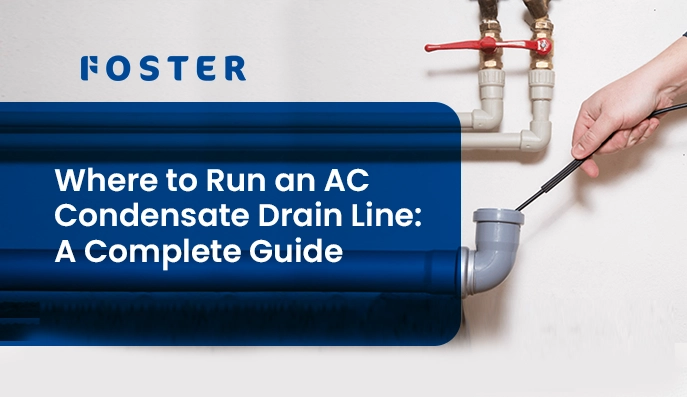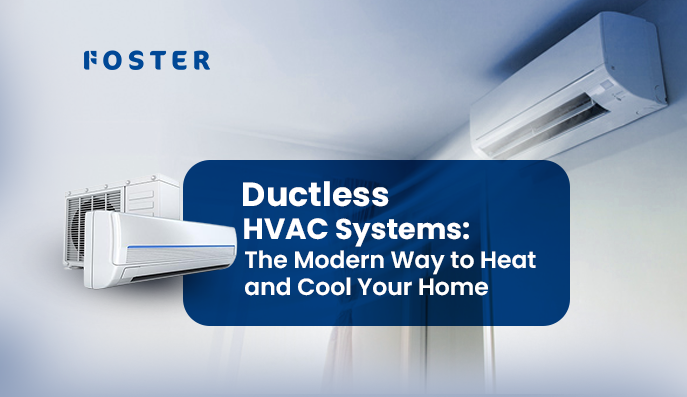Proper drain line routing prevents water damage, mold growth, and HVAC inefficiencies. Though often overlooked, the condensate drain line plays a key role in safely operating any air conditioning system. Whether you’re a homeowner, builder, or HVAC technician, understanding how and where to run an AC condensate drain line is a critical part of system design and maintenance. In this guide, we cover best practices for HVAC condensate drain routing, ensuring compliance with AC drain line requirements while maximizing system efficiency and longevity.
What is the AC Condensate Drain Line
The AC condensate drain line carries excess moisture collected from your air conditioning system to an appropriate drainage point. As warm air passes over the evaporator coils, condensation forms, which must be safely drained to prevent leaks and operational issues.
A properly installed drain line prevents water accumulation in the drain pan, reducing the risk of system failure and property damage. A properly installed drain line prevents water accumulation in the drain pan, reducing the risk of system failure and property damage.
Learn more about the full range of HVAC services that keep your heating, cooling, and ventilation systems running efficiently.
Where to Run an AC Condensate Drain Line
Choosing the right drainage location is essential for an efficient and trouble-free system. Recommended options include:
1. Outdoor Discharge
The most common and preferred method is routing the condensate line outside the building.
- Ensure the drain outlet is positioned away from the foundation to prevent erosion or water damage.
- If necessary, use a splash block or extension pipe to control water flow.
2. Connection to a Sink Drain
The condensate line can be connected to a nearby sink’s plumbing system.
- Ensure that the connection is made before the sink’s P-trap to prevent sewer gases from entering your HVAC system.
- A proper air gap is required to comply with plumbing codes.
3. Connection to a Plumbing Vent or Waste Pipe
Some systems allow routing the drain line into an existing waste pipe or plumbing vent.
- A correctly installed P-trap will prevent sewer gases from flowing back into the unit.
- Always check local building codes before selecting this option.
4. Underground Drainage System
Installing an underground pipe leading to a safe drainage location can be an excellent long-term solution.
- Ensure proper slope and protection from debris accumulation.
5. Condensate Pump (if Gravity Drain is Not Possible)
If the system is below ground level or needs to pump water upwards, a condensate pump can assist in draining the moisture to a designated outlet.
Key Installation Requirements
Industry best practices for AC condensate drain line installation include:
- Proper Slope: The drain line must be sloped downward at 1/4 inch per foot to allow gravity drainage.
- P-Trap Installation: Prevents air from entering the system and allows smooth drainage.
- Air Gap Inclusion: A vertical separation between the drain line and disposal point prevents backflow contamination.
- Pipe Size Standards: The standard requirement is 3/4-inch PVC or copper piping for residential AC drain lines.
- Cleanout Port Installation: Simplifies maintenance and prevents clogs from mold, algae, or debris.
Common Issues and How to Avoid Them
Improper AC condensate drain line installation can lead to serious HVAC failures. Common problems include:
- Clogs & Blockages: Prevented by regular flushing and using antimicrobial treatments.
- Backflow & Sewer Gas Entry: Avoided with P-traps and proper venting.
- Water Damage & Mold Growth: Ensured by maintaining correct drainage slopes and routine inspections.
- System Shut-offs: Prevented by float switch installation, detecting overflow before damage occurs.
Pro Tip: Regular system care is essential. Check out our preventative maintenance tips for your HVAC system to prevent common issues before they cause costly damage.
Professional Support for AC Drain Line Installation
For guaranteed code-compliant installations, call our certified HVAC professionals. With years of expertise in HVAC engineering and installation, we ensure every condensate drain line is installed with precision and full compliance with industry standards.
In need of expert guidance or professional AC condensate drain line installation? Foster International can help!
We provide:
- Industry-Compliant Installations – Meeting all local building codes and regulations.
- Reliable & Long-Lasting Solutions – Ensuring efficiency and durability.
- Expert Consultation & Maintenance – Helping clients prevent issues before they occur.
Get in Touch
If you’re looking for a partner to service your HVAC systems regularly, keep your systems optimal, and ensure predictive maintenance, book a consultation with Foster International today.
Let’s optimize your HVAC system for long-term efficiency!



 Previous Post
Previous Post

